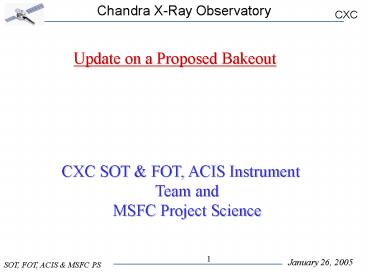Update on a Proposed Bakeout - PowerPoint PPT Presentation
1 / 11
Title:
Update on a Proposed Bakeout
Description:
This presentation is a summary of that work. Those contributing directly to this ... D. Shropshire, L. McKendrick, R. Logan, R. Giordano, T. Trinh, K. Chen, ... – PowerPoint PPT presentation
Number of Views:28
Avg rating:3.0/5.0
Title: Update on a Proposed Bakeout
1
Update on a Proposed Bakeout CXC SOT
FOT, ACIS Instrument Team and MSFC Project
Science
2
Contributors to the Bakeout Effort
TheACIS Contamination Working Group has been
studying the ACIS contamination issue for the
last two years. This presentation is a summary
of that work. Those contributing directly to this
presentation CXC P. Plucinsky, A. Vikhilin, H.
Marshall, N. Schulz, R. Edgar, D. Schwartz, S.
Wolk, H. Tananbaum, J. DePasquale, S. Virani, D.
Dewey, L. David MIT M. Bautz, C. Grant, W.
Mayer, R. Goeke, P. Ford, B. LaMarr, G Prigozhin,
S. Kissel, E. Boughan PSU G. Garmire, L.
Townsley, G. Chartas, D. Sanwal, M. Teter, G.
Pavlov MSFC S. ODell, D. Swartz, M. Weisskopf,
A. Tennant, R. Elsner NGST M. Mach, P.
Knollenberg, D. Shropshire, L. McKendrick, R.
Logan, R. Giordano, T. Trinh, K. Chen, K.
Henderson, F. Cottrell, J. Lamb, D. McGregor, H.
Tran, D. Lindemann, L. Harper, L. Ryan, A.
Tao LMA N. Tice
McMaster University A. Hitchcock
Many others have contributed directly or
indirectly.
3
New Items since Last CUC Briefing (June 2004)
- Tests on spare OBFs at NGST are complete and the
project is convinced that OBFs will not be
damaged during the bakeout - Chandra FOT determined that it is not safe to use
the additional heaters on the SIM to heat the
ACIS collimator/SIM interface - Project decided to postpone bakeout decision
until the impact of not using the heaters was
understood - MSFC Project Science generated new simulations
with these colder surfaces and not surprisingly,
the contaminant does not vent as effectively.
The recommendation is to keep the OBF warmer than
any of the surrounding surfaces during the
bakeout. - Calibration team continues to work on the
characterization of the contaminant (see Herman
Marshalls talk) - ACIS team is planning new irradiation tests to
better understand the mechanism for the CTI
increase from the room temperature bakeout in Sep
1999
4
Chandra X-Ray Observatory
ACIS Location
OBA Vent Locations
Contaminate Migration Path
Optical Bench Assembly (OBA)
Integrated Science Instrument Module (ISIM)
5
(No Transcript)
6
Geometric model
OBA vent
SIM focus structure
SIM translation table
Optical bench (OBA)
ACIS collimator
Snoot
OBA stove pipe
ACIS camera top
ACIS OBF
TRASYS model by NGST/ H. Tran et al.
7
10.DOP de-rated TOBF Mass column
ODell Swartz (MSFC)
1 ACIS OBF 2 Camera top 3 ACIS snoot 4 ACIS
collimator 5 SIM trans table 6 SIM focus
struc 7 OBA stove pipe 8 Optical bench 9 OBA
vent
NOMINAL
DE-RATED
8
1.0DOP de-rated TOBF Mass column
ODell Swartz (MSFC)
NOMINAL
DE-RATED
1 ACIS OBF 2 Camera top 3 ACIS snoot 4 ACIS
collimator 5 SIM trans table 6 SIM focus
struc 7 OBA stove pipe 8 Optical bench 9 OBA
vent
9
Limits on vaporization rates
ODell Swartz (MSFC)
Min to vent 0.2 g in 1 orb5?10-3 mg cm-2 s-1 _at_
Tcoldest
Min to clean OBF in 1 orb2?10-3 mg cm-2 s-1 _at_
TOBF-bake
Upper limit at OBF center1?10-7 mg cm-2 s-1 _at_
TOBF-ops
10
Conclusions From New Simulations
- If the contaminant has a volatility of less than
0.1 X DOPs volatility, a one orbit 30 C bakeout
will not move a significant amount of the
contaminant - If the contaminant volatility is within an order
of magnitude of DOPs volatility, a significant
amount of the contaminant will vaporize and
migrate to the cold surfaces at the top of the
ACIS collimator and the SIM. The contaminant
will then migrate very slowly back to the OBF and
it may be years before a significant amount
re-accumulates on the OBF - If the contaminant volatility is an order of
magnitude higher than that of DOP, a significant
amount of the contaminant will vaporize and
migrate to the cold ACIS collimator and SIM
surfaces. The contaminant will then migrate back
to the OBF such that after 1 year, the thickness
will be 1/3 of the original thickness.
11
Work Still to be Done (January 2004)
- ACIS team will conduct irradiation tests,
analyze the results, and refine the prediction
for the effect of another room temperature
bakeout on the CTI - The working group will prepare another briefing
for the Chandra project and seek approval for the
bakeout































